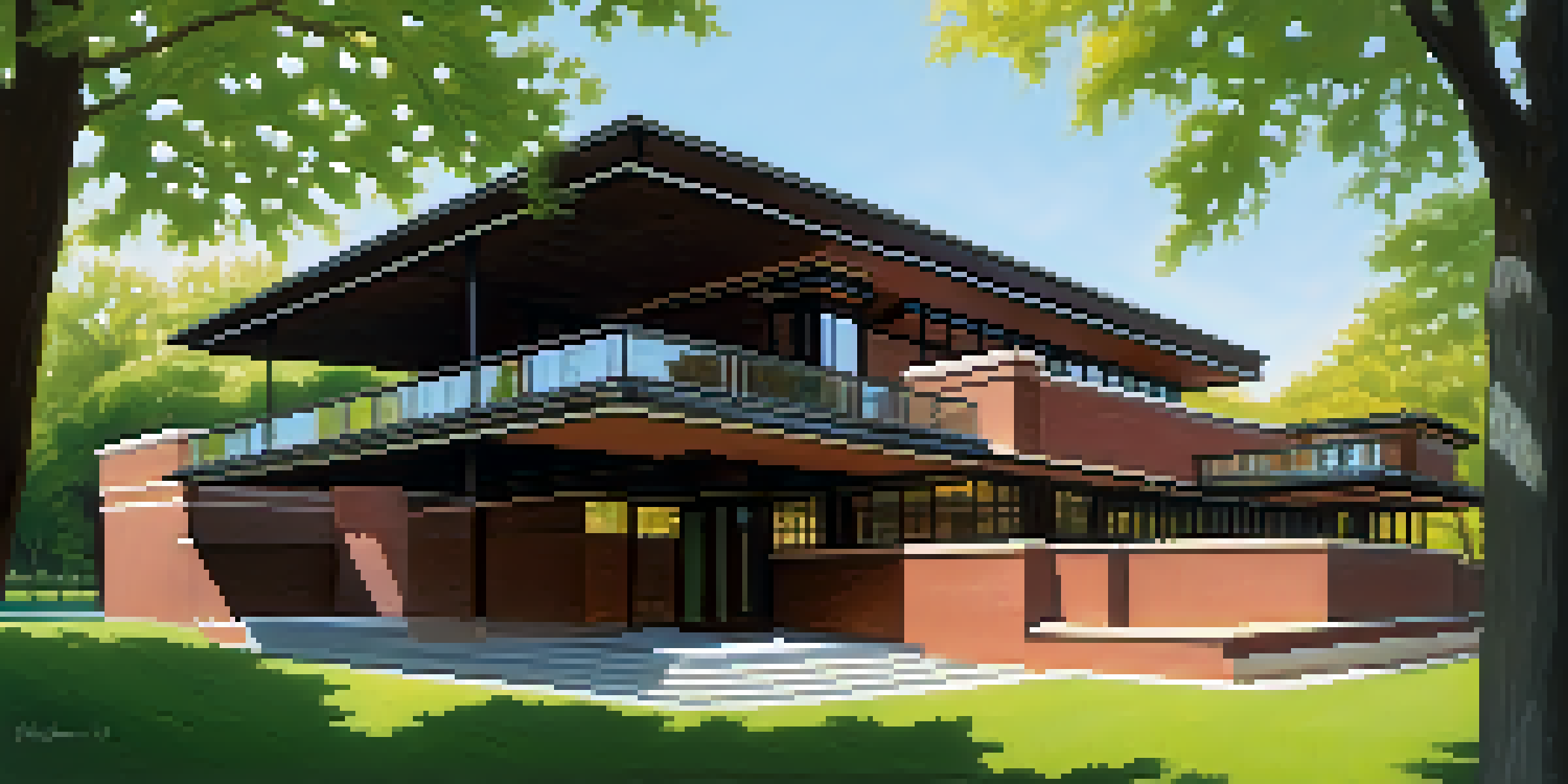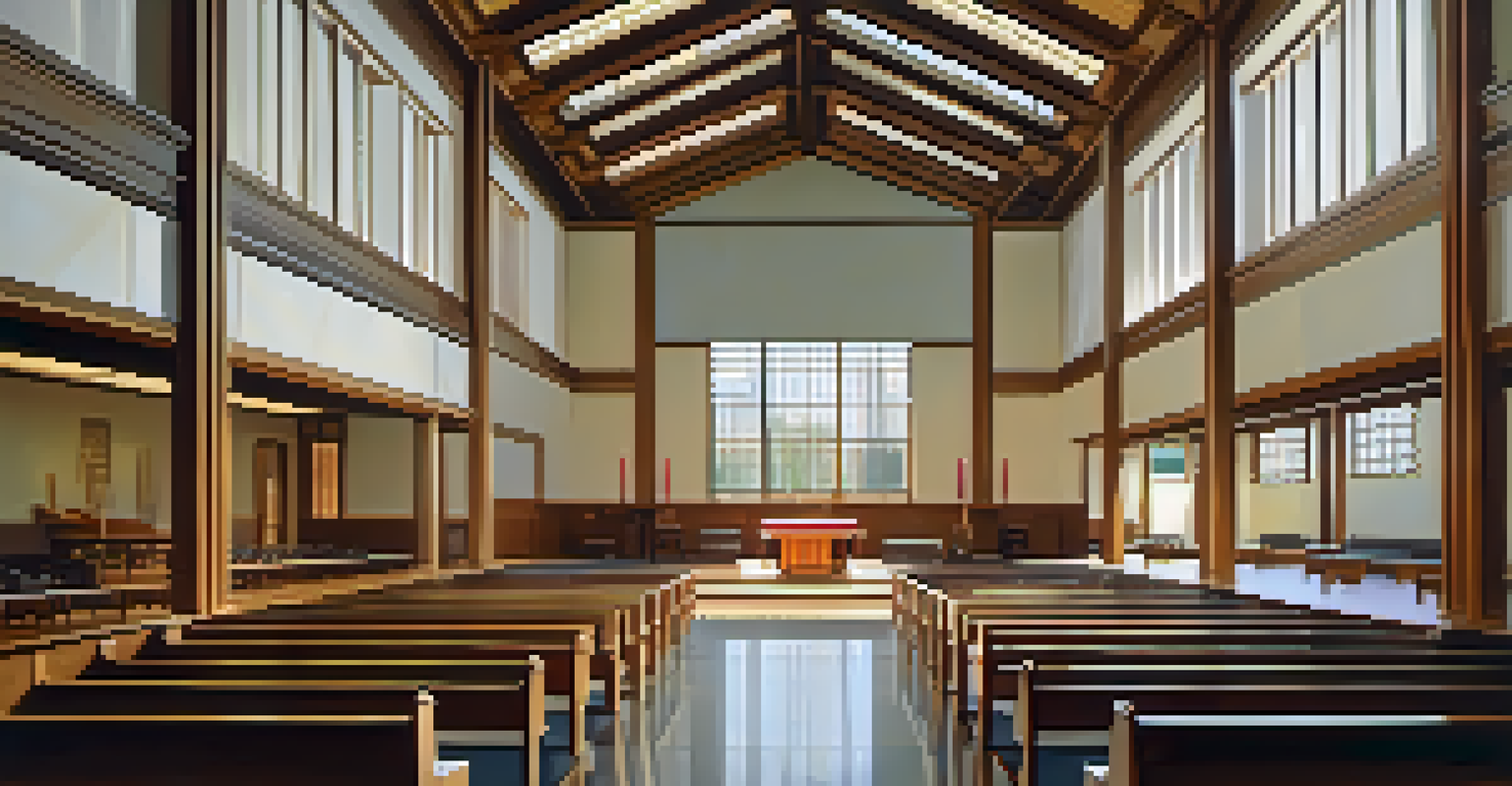Frank Lloyd Wright: Architectural Innovations in Chicago

Introduction to Frank Lloyd Wright's Legacy in Chicago
Frank Lloyd Wright, an iconic figure in American architecture, is renowned for his innovative designs that reshaped the urban landscape of Chicago in the early 20th century. His philosophy was rooted in the idea of creating harmony between structures and their environments, which he called 'organic architecture.' This approach not only transformed buildings but also influenced the perception of architecture as a whole.
The mother art is architecture. Without an architecture of our own, we have no soul of our own civilization.
Wright's commitment to design was not just about aesthetics; it was about creating spaces that enhanced the human experience. His work in Chicago laid the groundwork for modern architecture, showcasing how buildings could seamlessly integrate with their surroundings. By prioritizing natural materials and open spaces, he encouraged a new way of living that resonated deeply with the evolving American culture.
As we dive deeper into Wright's contributions, we will explore specific projects that highlight his innovative techniques and philosophies. From the Prairie School movement to his later works, each project reflects a unique blend of creativity and practicality that continues to inspire architects today.
The Prairie School: A New Architectural Movement
The Prairie School was a distinctive architectural movement that emerged in the late 19th and early 20th centuries, with Wright at its forefront. Characterized by low, horizontal lines and an emphasis on craftsmanship, this style sought to create buildings that mirrored the flat, expansive Midwest landscape. Wright’s designs often featured large overhanging eaves and open floor plans, allowing for a natural flow between indoor and outdoor spaces.

One of the most famous examples of Prairie School architecture is the Robie House, completed in 1910. This masterpiece showcased Wright's signature style and was a radical departure from the ornate Victorian homes of the time. The house's integration with its site and innovative use of space exemplified how architecture could reflect the values of the American spirit.
Wright's Organic Architecture Philosophy
Frank Lloyd Wright's commitment to organic architecture emphasized harmony between buildings and their natural surroundings.
The Prairie School's influence extended beyond individual buildings; it sparked a broader conversation about the purpose and function of architecture. By promoting a style that embraced the surrounding landscape, Wright encouraged other architects to think critically about their designs and the impact they have on their communities.
Innovative Use of Materials and Designs
Wright was known for his innovative use of materials, often integrating local resources into his designs. He believed that architecture should be rooted in its environment, which led him to utilize materials like brick, wood, and stone in ways that celebrated their natural beauty. This approach not only enhanced the aesthetic appeal of his buildings but also created a sense of place that resonated with the local culture.
Space is the breath of art.
Additionally, Wright's designs often featured large windows and open spaces that blurred the lines between indoor and outdoor living. For example, the Unity Temple, completed in 1908, was groundbreaking in its use of concrete and natural light, creating a serene atmosphere for worshippers. This focus on creating harmonious environments was revolutionary and set a new standard for architectural design.
By challenging traditional construction methods and encouraging the use of innovative materials, Wright paved the way for future generations of architects. His ability to blend functionality with artistic expression remains a hallmark of his work and continues to inspire modern architectural practices.
The Influence of Nature on Wright's Designs
Nature played a pivotal role in Frank Lloyd Wright's architectural philosophy. He believed that buildings should reflect the natural world, rather than dominate it. This belief led him to create designs that harmonized with their surroundings, often incorporating natural elements directly into the architecture, such as plants and water features.
Wright's Fallingwater, though not in Chicago, serves as a prime example of this philosophy. The house is built over a waterfall, allowing the sounds and sights of nature to become an integral part of the living experience. This deep connection to nature not only enhances the aesthetic quality of a building but also promotes a sense of tranquility and well-being for its inhabitants.
Influence of the Prairie School
The Prairie School movement, led by Wright, introduced a design aesthetic that emphasized horizontal lines and integration with the landscape.
In Chicago, this philosophy is evident in the design of the Larkin Building, where Wright incorporated large windows to bring in natural light and views of the outdoors. By embracing nature in his architectural designs, Wright encouraged a lifestyle that valued harmony with the environment, a concept that remains relevant today.
The Impact of Wright’s Work on Chicago’s Urban Landscape
Wright's innovative designs significantly impacted Chicago's urban landscape, inspiring a generation of architects and urban planners. His work introduced a new aesthetic that balanced modernity with a sense of place, influencing the development of the city during a time of rapid growth and change. Buildings like the Winslow House and the Hollyhock House showcased his unique vision and became landmarks in their own right.
Moreover, Wright's emphasis on integrating architecture with nature prompted a shift in how urban spaces were designed. His ideas on open spaces and communal areas encouraged planners to consider the relationship between buildings and their surroundings, leading to more thoughtful urban development practices. This shift laid the groundwork for future architectural movements that prioritized sustainability and community.
As Chicago continued to evolve, Wright's influence remained evident in the city's architectural landscape. His principles of organic architecture and attention to the environment continue to inform current design practices, making his contributions to Chicago's identity both timeless and relevant.
Wright’s Later Works and Their Significance
In the latter part of his career, Frank Lloyd Wright expanded his architectural vision beyond Chicago, creating some of the most iconic buildings in the country. Projects like the Guggenheim Museum in New York and Taliesin West in Arizona exemplify his continued evolution as an architect. These works not only reflect his distinctive style but also demonstrate his commitment to innovation and creativity throughout his career.
Wright's later works often incorporated even more experimental designs and materials, pushing the boundaries of architecture. For instance, the Guggenheim's spiraling form challenged traditional notions of museum design, creating a space that was as much about the experience of the visitor as it was about the art displayed within. This approach redefined how we think about public spaces and their functionality.
Legacy in Urban Development
Wright's innovative designs inspired a generation of architects, significantly shaping Chicago's urban landscape and promoting sustainable practices.
Even as he moved away from Chicago, Wright’s impact remained deeply felt in the city. His principles and philosophies continued to inspire architects and urban planners, ensuring that his legacy lived on. Today, many of his ideas about sustainability and human-centered design are more relevant than ever, influencing the way we approach architecture in urban environments.
Conclusion: Frank Lloyd Wright's Enduring Influence
Frank Lloyd Wright's contributions to architecture, particularly in Chicago, have left an indelible mark on the field. His innovative designs, commitment to organic architecture, and emphasis on the relationship between buildings and nature have reshaped how we view and interact with our surroundings. As we reflect on his legacy, it becomes clear that Wright was not just an architect, but a visionary who dared to challenge the status quo.
His work continues to inspire new generations of architects and designers, encouraging them to think critically about the role of architecture in shaping human experiences. By prioritizing sustainability, community, and harmony with nature, Wright's principles are more relevant today than ever. The buildings he designed are not just structures; they are a testament to the power of thoughtful design and its potential to influence lives.

As we move forward in an ever-evolving architectural landscape, remembering Wright's innovations serves as a reminder of the importance of creativity and integrity in design. His legacy will undoubtedly continue to inspire and inform the future of architecture, ensuring that his vision of a harmonious relationship between humanity and nature lives on.